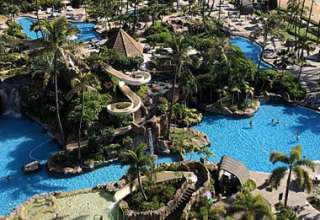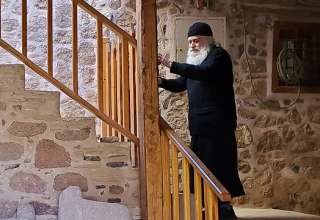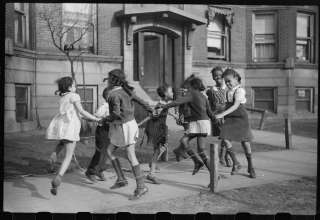London, Paris, Berlin and Udine. Yes, Udine. And let’s not forget about Grado, Salice and Trieste, most definitely Trieste. This is the Friuli-Venezia Giulia region of Italy, spread across the far northeastern corner of the nation. I first read about this stunning region of diverse landscapes, languages and cultures over 15 years ago and swore that someday I would see it for myself. This last pre-covid June I finally did something about it.
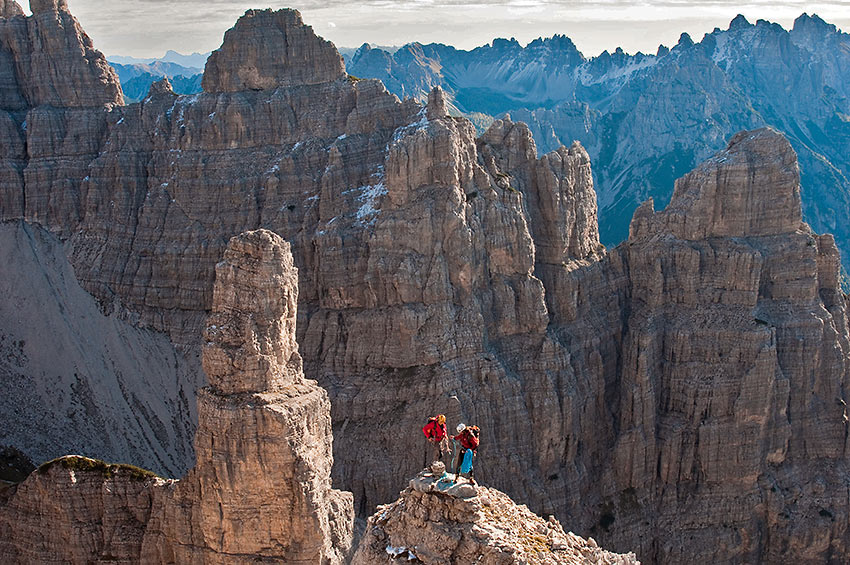
Overlooking the Adriatic Sea, bordering Austria, Slovenia and Italy’s Veneto region, I predict that once the word gets out, this enchanting, little-known region is poised to become one of nation’s hottest travel destinations. Friuli-Venezia Giulia also constitutes a new backdoor to Italy concept; just fly to Venice, visit the sights and battle the crowds, then hop in a car or bus. Within an hour you will be immersed in a world of pristine vineyards, charming villages and farms, glacial lakes, lagoons and rivers, world-class beach resorts, Roman ruins and historical cities, all with the towering Dolomites as a backdrop. It’s the type of region where you can go skiing in the mountains and enjoy a seafood meal on the Adriatic in a single day. Perhaps you may want to stop for a glass of wine in the central plateau’s Wine and Dine route, Italy’s third largest wine quality region. Multiculturalism is reflected and respected with four official regional languages: Italian, Slovenian, German and Friuli, a language courtesy of the Carnics, a Celtic population who remained in the Carnic Alps dating back to the time of the Romans. Friuli Venezia Giulia not only embraces all forms of ethnicity; it is defined by it. I liked that a lot, particularly with the current trend in the U.S. to have a disdain for any form of cultural diversity and identity.
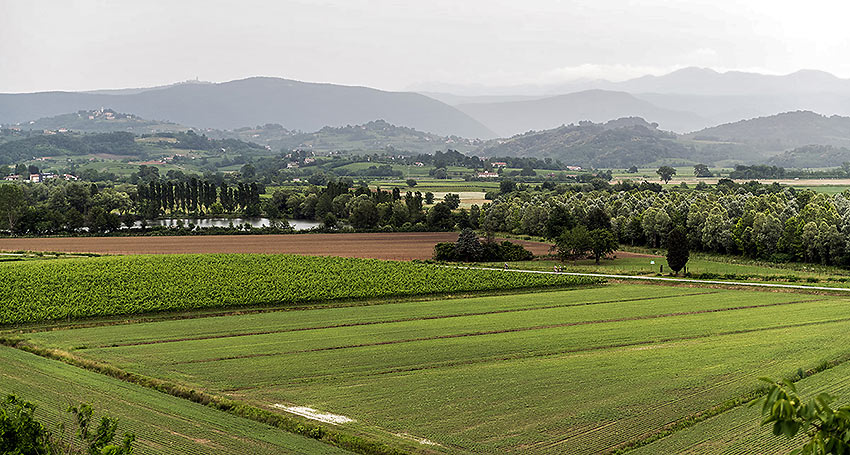
Sipping a glass of Collio Bianco Col at Roberto Felluga’s tranquil Russiz Superiore Winery, it occurred to me that I’ve never experienced a region quite like it in Italy. This seemingly untouched piece of paradise offered an authentic form of travel, devoid of hordes of tourists and sometimes cynical merchants that dominate many of Italy’s more famous attractions.
Selected Highlights
Trieste
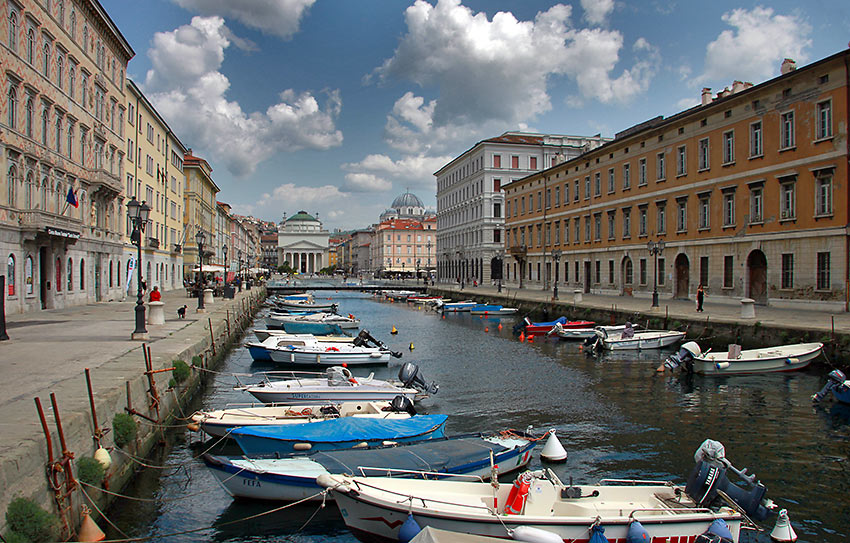
If you can smell the coffee, you must be in Trieste. The most international city of Friuli Venezia Giulia, this endearing regional capital evokes the ambiance of Vienna’s coffee culture of the past, while serving as a seaside salon today. This should come as no surprise for Trieste was once part of the Habsburg Empire, giving the landlocked Austro-Hungarians a precious piece of the Adriatic for commercial transport. Sitting at the base of the Karst Plateau, almost entirely surrounded by Slovenia, the city is physically isolated from the rest of the Italian peninsula, and became home to literary giants like Umberto Saba, Italo Svevo, and Dublin ex-pat James Joyce, who wrote The Dubliners, Portrait of An Artist as a Young Man and half of Ulysses during his 14 years in the city. Like many cities of the region, Trieste evokes a blend of its romantic past and today’s sense of cosmopolitanism. Sidewalk cafes line the idyllic main square, Piazza Unita’ d’Italia, which opens to the cool breezes of the Adriatic. Locals leisurely go on with their daily life, and then enjoy the sea for sunbathing, swimming or just strolling. Trieste is a compact city, with its history, literary traditions and art; a seamless fusion of Roman, medieval and Habsburg period architectural styles, all easily accessible on foot.
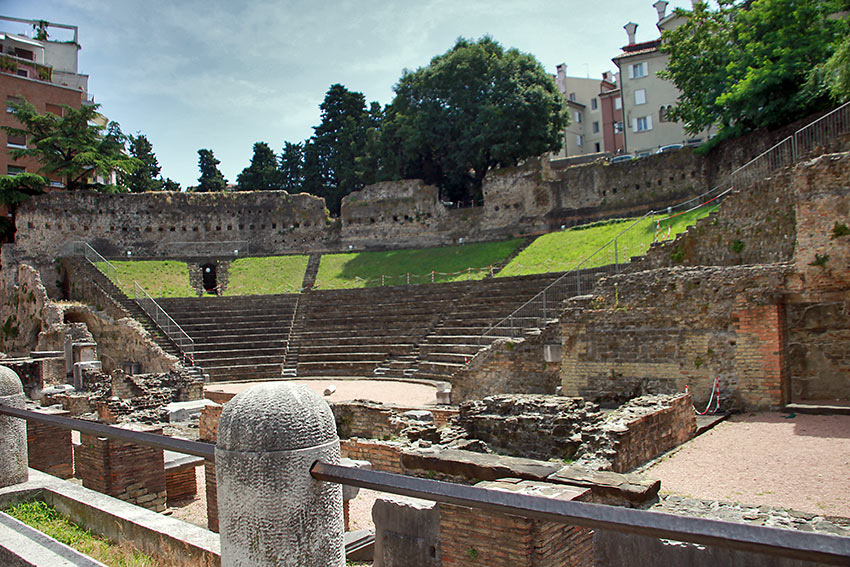
A Roman amphitheatre (circa B.C.) is located at the foot of the San Guisto Hill in the heart of Old Town. Once buried under modern buildings, it was uncovered by archeologists in the 1930s, and is one of the remaining 230 amphitheatres scattered across the former Roman Empire. For lovers of decorum luxury, Miramare Castle, compliments of Habsburg Archduke Maximilian – later short-lived emperor of Mexico until assassination – sits on a bluff, overlooking the sea.
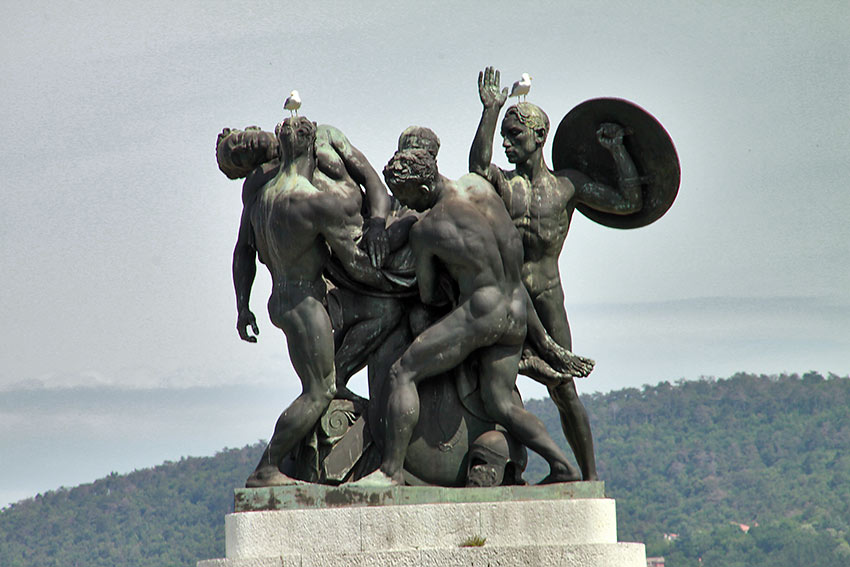
At the end of Parco della Rimembranza (Memory Park) is the Monument to the Fallen Soldiers of Trieste which pays homage to the war dead of the Great War. The Battle of Caporetto, considered the most treacherous battle of war, took place in the mountains outside the city. In the successful Austrian and German advance more than 600,000 war-weary Italian soldiers died, deserted or surrendered in the bitter mountain warfare. The battle was described by Ernest Hemingway in his masterpiece A Farewell to Arms, based on his experiences when he was an 18-year-old ambulance driver in Italy for the Red Cross.
Sacile
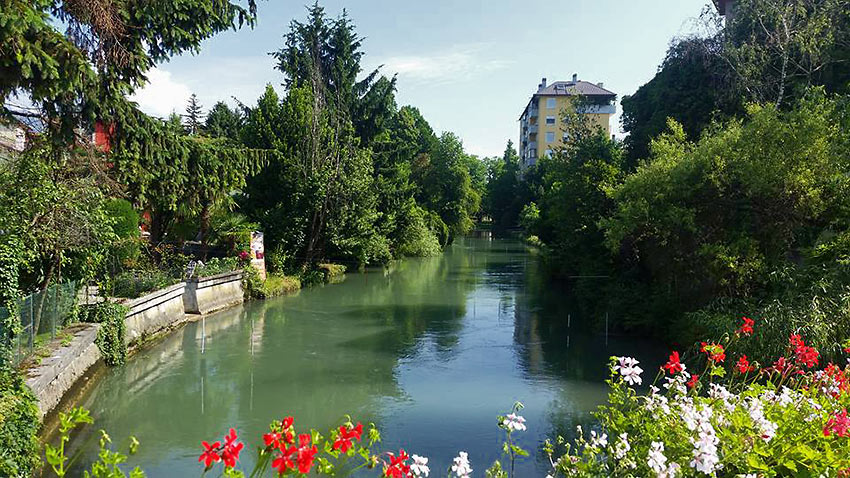
Mere words cannot describe the ethereal beauty of Sacile; almost more of a fairy tale than a village. Located outside of the small city of Pordenone – itself worth a look – it is known as the Garden of the Serenissima due to the many palaces along the Livenza River, built for the nobility at the time of the Venetian Empire. With its array of picturesque little canals and bridges, palaces reflecting in the water, gorgeous flowers and vegetation, it is a tranquil and romantic venue to simply stroll or relax on a park bench, a true photographer’s delight.
The Friulian Dolomites
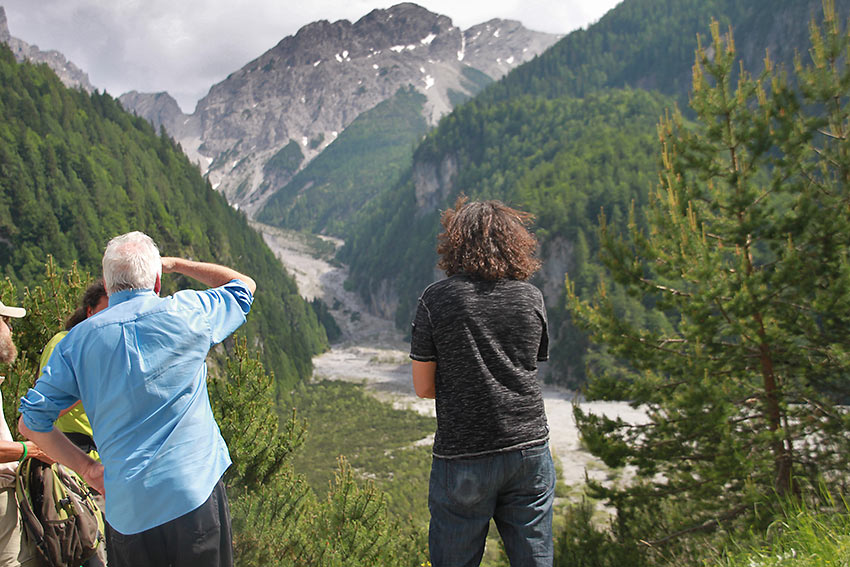
A UNESCO World Heritage Site, the Friulian Dolomites stand proudly high above the clouds at a towering 7122 ft. in the far western mountain area of Friuli-Venezia Giulia. Considered the most untouched area of the entire Dolomite range, its symbol is Campanile di Val Montanaia, an isolated rock pinnacle on the summit that looks like a bell tower. Readers note: Only the fittest climbers would challenge an ascent to the peak, but iconic images of the tower, surrounded by spectacular karst formations, can be easily photographed from lower trails. For low-impact trekkers – in other words, lightweights like me – there are well-kept forested paths and trails, meadows, glacial rivers, brilliant green lakes, dramatic limestone topography and caves.
Udine
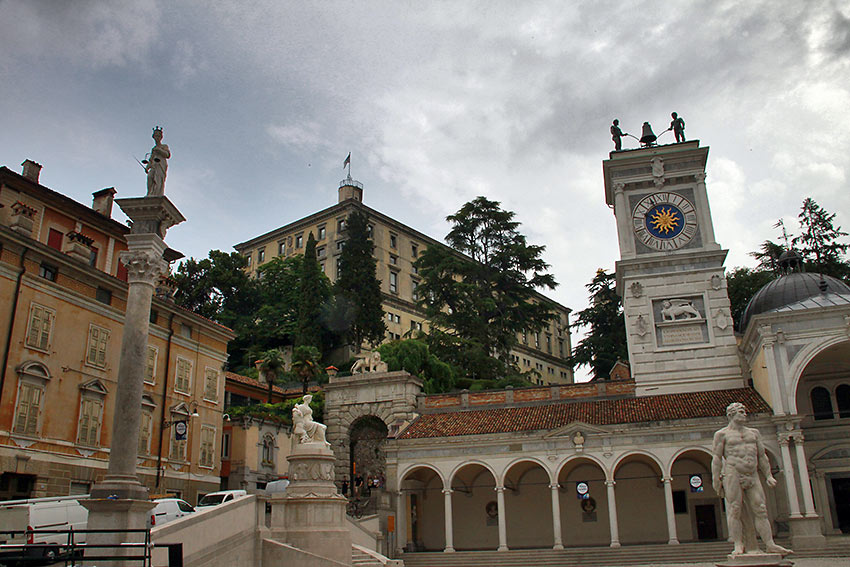
Udine has been inhabited since the Neolithic age and is recognized as the most historical capital of the region. History tell us that Attila, the leader of the warlike Huns, built a hill and a square-shaped tower in Udine when besieging Roman Aquileia. Due to legend, he instructed his soldiers to transport soil in their helmets and shields, because the landscape was too flat. Aquileia, once the second largest city in the Roman Empire was eventually sacked by Attila’s Huns, resulting in its citizens escaping to the southwest, eventually establishing Grado and Venice. After the fall of Western Roman Empire, Udine increased in importance becoming part of the Republic of Venice, the newly formed Kingdom of Italy, and later the seat of the Italian High Command during the Great War. Before the Italian Army’s devastating defeat in the Battle of Caporetto, Udine was known as the “War Capital.” Hemingway devotes long passages about Udine in A Farewell to Arms:
“He lived in Udine and came out in this way nearly every day to see how things were going, and things went very badly. At the start of the winter came the permanent rain and with the rain came the cholera. But it was checked and in the end only seven thousand died of it in the army.”
– Ernest Hemingway
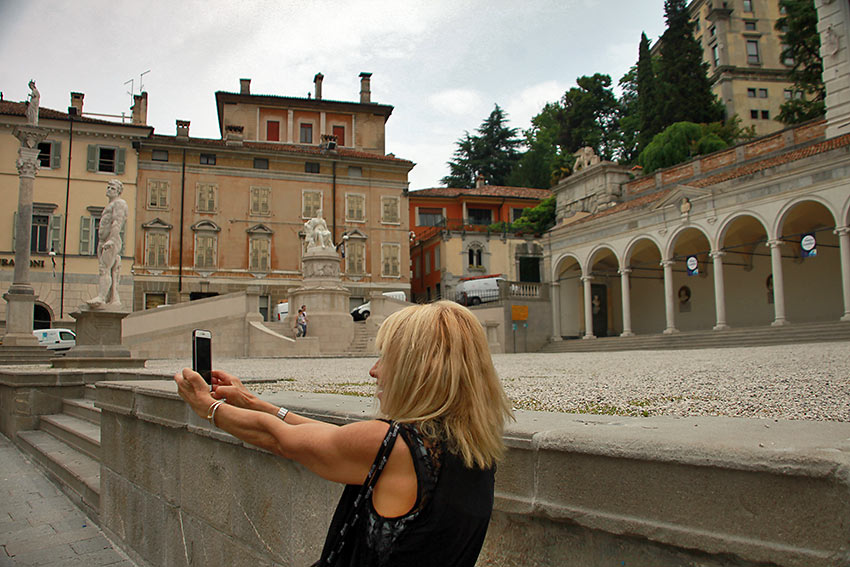
Today the city and provincial capital of Udine dominates Friuli-Venezia Giulia’s inland plains and alpine peaks, offering a unique taste of history: A ring road surrounds a stunning and compact pedestrian-only medieval center, complete with Roman columns, Venetian arches and Grecian statues. Renowned for its regional cuisine and white wines – which possess a crisp Germanic precision – along with traditional food items such as Prosciutto di San Daniele – similar to Prosciutto di Parma, but less robust and more sublime – white asparagus, and Montasio – a creamy, unpasteurized mountain cheese – it is considered the gastronomic capital of Friuli. Among this thriving cityscape there’s a plethora of local bars and sidewalk cafes where one can bask in the city’s wonders. In the countryside, the province is marked with numerous villas, towers, abbeys and castles.
In Part II of A Piece of Paradise: Friuli-Venezia Giulia Region my journey continues with explorations of the Roman city of Aquileia, the Cellina Nature Reserve, Grado – the “Golden Island,” and the Food & Wine of the region.
For further information about Friuli Venezia Giulia, click HERE.
